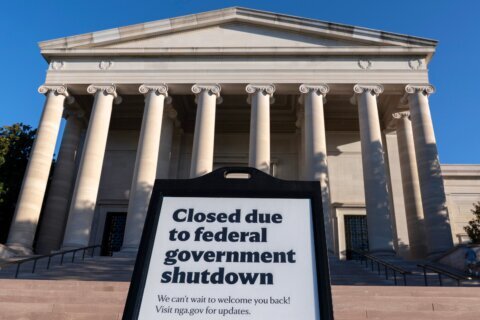This video is no longer available.
It’s been more than a month since New Year’s revelers rang in 2024. But for the D.C. area’s Asian American communities, it’s time to bring out the rice cake, wrap some dumplings and hand out some red envelopes and ring in 4722 — the Year of the Dragon.The Lunar New Year starts next Saturday, Feb. 10 — that’s when the Chinese lunar calendar begins. It’s the most important holiday in several East Asian countries, and is typically marked by a weeklong holiday and mass travel back home to reunite with family.
In the D.C. area, those who observe the holiday may not get a week off, but they celebrate in ways that preserve and honor their culture and traditions.
- Q:
What is Lunar New Year?
- A:
The Lunar New Year is the most important holiday in many East Asian countries, as it’s the start of the Chinese lunar calendar. The holiday starts anytime from mid-January to mid-February depending on the year.
“It’s originally based on the agriculture, farming,” said John Lin, chair of the City of Rockville’s Asian Pacific American Task Force.
In China, it’s called the Spring Festival, as it marks the end of winter, with the weather starting to warm up. The holiday is also observed in South Korea, where it is known as Seollal, and Vietnam, where it is known as Tet.
- Q:
How does the DC area celebrate the Lunar New Year?
- A:
In the D.C. area, you may not get a week off like in other countries, but families still make time to visit relatives and have a meal together.
Asian grocery stores bustle with shoppers buying all kinds of groceries, including specialty rice cakes, dumpling ingredients and red envelopes. Even big-box stores, such as Costco, are featuring goodies with dragon-themed packaging.
“The No. 1 is the family get-together,” Lin said. Families gather together to have a nice meal symbolizing their bond. “We are together; we are healthy, and it’s a really good feeling that you expect year after year.”
Rita Lee, events vice chair for the Chinese Consolidated Benevolent Association — which organizes the D.C. Chinatown parade — said that the table where everyone gathers is often round — “meaning lucky.”
“Everything in a circle is the harmony,” Lee said. “In Chinese, we have to eat in the round table. Everybody around together — meaning harmony.”
Lin said some families who have been settled for a long time in the U.S. may not keep up with all the traditions around the Lunar New Year, but new immigrants do.
“They make dumplings together. And also, the parents will have a feast. They make a lot of dishes, and bring all the children home and get together,” Lin said.
It’s also a time to visit relatives.
The first day is usually reserved for visiting parents and immediate family, said Minh Pham, head of PSK Creative, which puts together events that highlight the Vietnamese American community in the D.C. area.
Then there’s a list of relatives you visit to pay your respect, including the older generation. The next few days are for visiting extended family.
- Q:
How is the Lunar New Year celebrated in other countries?
- A:
In China, the Spring Festival is marked by a weeklong public holiday and mass travel to their hometowns for family reunions.
Lee, with CCBA, compares the mass exodus home to Thanksgiving or Christmas in the U.S.
“American Thanksgiving, everybody goes home around the Thanksgiving or Christmastime. So to us, it’s like a big celebration,” Lee said. It’s also a time for rest, to take a break from the hard work they did in the past year and prepare for the following year, she added.
“The people rest enough and enjoy the food and family together, and everybody celebrates together. After that, everybody goes back,” Lee said.
On the first day of Lunar New Year, people in Vietnam would get in line at the temple or at a school and ask for a “lucky” letter, Pham said.
The calligraphy would symbolize happiness, luck or a sentiment for the new year, and it is usually written on silk scroll.
“They would bring it home and then display it in their home,” Pham said.
Lin, with the Rockville Asian Pacific American Task Force, said he remembers having the best time celebrating the new year with fireworks and red envelopes, which contain some money.
“That’s the best time I’ve ever had during the year. We played together, and everywhere we go, there’s a fireworks, and then the younger generation will get a red envelope, which contains anywhere from $1 to $10,” Lin said.
Like in China, people in Vietnam have about two weeks off for Tet.
“They travel … they take a break,” Pham said. But the most important day is the first day — the time with the immediate family, Pham said.
Lee, who is from Taiwan, said the first few days is also a time for the women, who have been preparing for weeks for the Lunar New Year, to rest. She remembers her mother cooking for weeks to get everything ready.
“The women, they’ve been working so hard cooking for the family for past year,” Lee said, that on the first three days, they don’t cook, but everything is premade and ready for others to enjoy.
- Q:
Speaking of food, what is typically eaten during Lunar New Year?
- A:
“First of all, is a rice cake,” Lee said. Called nian gao, it’s sticky and very sweet. The family “sticks together,” and it’s considered very lucky to eat rice cake during the Lunar New Year, Lee said. People also eat a sweet rice ball (remember round means luck), with a sweet been sauce inside.
“Korean and Korean Americans specifically eat a rice cake soup during the Lunar New Year because the oval shape of the rice cakes actually resemble coins and symbolize the wish for a prosperous year, ” said Nicole Dowd, head of public programs at the Smithsonian National Museum of Asian Art.
People also eat fish, which is served whole. In Chinese, the word fish is pronounced “yu” — the same pronunciation for the word “surplus,” which symbolizes wealth and prosperity, according to the Food Network.
Another traditional food to eat are noodles, which symbolizes long life. Lee said the noodle is never cut in half, but eaten similar to spaghetti.
“You roll and roll. You don’t cut in half because that is symbolizing yours will be the long life and healthy,” Lee said.
Then there’s dumpling, where inside “we put a coin,” but these days, Lee said it might be a piece of candy and whoever gets the one with a prize inside will have good fortune.
- Q:
What’s inside the red envelope?
- A:
One of the best-known traditions of the Lunar New Year is the giving of red envelopes.
Predominantly seen among Chinese culture, it actually ranges across Asian culture, Dowd, with the Smithsonian, said.
The envelopes contain money and are meant to bring good luck.
“Usually they’re given to children, but friends can give them to one another as well,” Dowd said.
- Q:
What are the animals of the Lunar New Year?
- A:
This is the Year of the Dragon, which is a symbol of strength and wisdom and good fortune prosperity. Similar to Western astrology, in the Chinese calendar, the year you were born might determine your personality, and each year is represented by an animal — a Chinese zodiac sign.
Learn more about what animal corresponds to the year you were born.
“That’s kind of a metaphor,” Lee said about the stories people would tell that suggest when you were born determines your personality, appearance or attributes. “Now the time is different. People don’t care” whether you’re born the year of the dragon or any other year, she said, adding that many older people still believe.
- Q:
Where can I learn more about the Lunar New Year?
- A:
There are several events taking place in the D.C. area that are having Lunar New Year events, including:
- D.C. Chinese Lunar Parade on Feb. 11
- The Lunar New Year Family Celebration at the Smithsonian American Art Museum on Feb. 10
- Eden Center Lunar New Year Celebration on Feb. 10 and Feb. 11
- City of Rockville Lunar New Year on Feb. 17 (canceled)
The Smithsonian’s National Museum of Asian Art has resources where you can learn more about the holiday.
Get breaking news and daily headlines delivered to your email inbox by signing up here.
© 2024 WTOP. All Rights Reserved. This website is not intended for users located within the European Economic Area.








